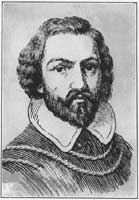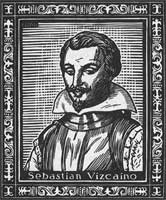


The Spanish were skilled sailors and explorers, they had already ‘discovered’ the Americas and the King of Spain decided it would be a good idea for Spain to travel to the West again to see if they could find a quicker route to Asia and locate land for Spain to claim.
Hernan Cortez had traveled from the Caribbean to Central America and conquered the Aztecs, a very large and strong civilization in what is now Mexico. Spain named their new country New Spain and with this foothold on the continent Spain planned to travel further north. Other explorers such as Coronado and Cabrillo had both explored the west coast and didn’t find riches like those from the Aztecs. Spain focused on colonizing and building the number of people, or population, in New Spain instead.
 Juan Cabrillo had served in Cortez’ army and was given the task of sailing up the Pacific Coast of North America to find what mapmakers from the day thought was a river from the Atlantic Ocean to the Pacific Ocean and to discover new lands for Spain. We know now that there isn’t a river that runs between the two coasts, but the maps of the day were incorrect. Cabrillo and his crew sailed from the town of Navidad in New Spain on June 24, 1542. It took Cabrillo and his crew over three months to reach what would become the first port in Alta California. He named the port San Miguel, the name was changed years later by another explorer, Sebastian Vizcaino to the name it holds today, San Diego.
Juan Cabrillo had served in Cortez’ army and was given the task of sailing up the Pacific Coast of North America to find what mapmakers from the day thought was a river from the Atlantic Ocean to the Pacific Ocean and to discover new lands for Spain. We know now that there isn’t a river that runs between the two coasts, but the maps of the day were incorrect. Cabrillo and his crew sailed from the town of Navidad in New Spain on June 24, 1542. It took Cabrillo and his crew over three months to reach what would become the first port in Alta California. He named the port San Miguel, the name was changed years later by another explorer, Sebastian Vizcaino to the name it holds today, San Diego.
Cabrillo’s expedition continued up the California coast, discovering other wonderful harbors including one that what would eventually be named the Monterey Bay, because of thick fog, though, they sailed by the San Francisco bay without seeing it.
The journey was difficult due to bad weather and heavy seas. Cabrillo died 6 months after sailing from New Spain from injuries he received during the journey.
 The King of Spain tried again 60 years later and sent Sebastian Vizcaino to find the water route. Vizcaino failed also, but heard that ships from Russia, Portugal, and England had visited the coast. Spain was concerned that England and Russia might try to settle the land and claim it for themselves. Occupying a land is one way to keep others off of it. Russia had already come down the Pacific Coast from the northern coast of Alaska and had settled at Fort Ross in Bodega Bay north of what is now San Francisco. The Russians had come to California to hunt sea otters for their skins, called pelts. Colonizing the coast would also allow Spanish trade ships from Asia safe harbors with food and supplies on their way back across the Pacific Ocean so the King’s ministers devised a plan to settle the area using Missions which would help convert the native peoples and make them into citizens of Spain.
The King of Spain tried again 60 years later and sent Sebastian Vizcaino to find the water route. Vizcaino failed also, but heard that ships from Russia, Portugal, and England had visited the coast. Spain was concerned that England and Russia might try to settle the land and claim it for themselves. Occupying a land is one way to keep others off of it. Russia had already come down the Pacific Coast from the northern coast of Alaska and had settled at Fort Ross in Bodega Bay north of what is now San Francisco. The Russians had come to California to hunt sea otters for their skins, called pelts. Colonizing the coast would also allow Spanish trade ships from Asia safe harbors with food and supplies on their way back across the Pacific Ocean so the King’s ministers devised a plan to settle the area using Missions which would help convert the native peoples and make them into citizens of Spain.
Spain had already established settlements in what is now Mexico (Baja California and New Spain), Florida, and Texas and as far south in Central American to Guatemala. Spain had learned from its conquering of the Aztecs what to do and not to do when trying to take over a people’s land. King Carlos had two main reasons for establishing Missions. The Missions helped Christianize the natives which made them Catholic converts, or neophytes, for the Catholic Church and citizens of the crown of Spain.
Spain was a Catholic country. That means that they followed the teachings of the Catholic Church. Within the Catholic Church it was divided into different groups. Three main groups, the Jesuits, Franciscans, and Dominicans were involved with the colonization of Alta and Baja California.
King Carlos allowed the Jesuits to found and run the Baja California Missions but in June 1767 they were transferred to Franciscan control. The Spanish government thought the Jesuits were becoming too powerful. The Jesuits had been given control over the missions and the soldiers that lived at the military forts or presidios. Spain decided that the Franciscans would still have control over the running of the missions, but that they would not be in control of the soldiers.
 The Franciscans sent Father Junipero Serra to found the first Alta California Mission. His goal was to reach the harbor that Cabrillo had found and named San Miguel and that Vizcaino had claimed for Spain under the name of San Diego. Father Serra and the Governor of New Spain decided to split the expedition into groups that would go by land and by sea. Three ships, the San Carlos, San Jose, and San Antonio sailed during the first six months of 1769 and two groups of soldiers and priests went overland. It was a difficult trip and many men died; the San Jose was lost at sea--no one on the ship survived. The sea routes were very important, and that is why most missions are near the coast, the mountain ranges and deserts in Alta California made it difficult to reach the coast from inland.
The Franciscans sent Father Junipero Serra to found the first Alta California Mission. His goal was to reach the harbor that Cabrillo had found and named San Miguel and that Vizcaino had claimed for Spain under the name of San Diego. Father Serra and the Governor of New Spain decided to split the expedition into groups that would go by land and by sea. Three ships, the San Carlos, San Jose, and San Antonio sailed during the first six months of 1769 and two groups of soldiers and priests went overland. It was a difficult trip and many men died; the San Jose was lost at sea--no one on the ship survived. The sea routes were very important, and that is why most missions are near the coast, the mountain ranges and deserts in Alta California made it difficult to reach the coast from inland.
The Franciscan Missionaries had a book of ‘rules’ written by Spain from what they had learned about founding the other missions. The book included info on how to entice natives to join the missions, what the daily schedule should be, and other details. With the rules in mind Father Serra founded Mission San Diego de Alcala in 1769 and began the Spanish colonization of Alta California. Father Serra established 9 missions before his death and burial at Mission San Carlos. Eventually 21 Missions were built in the 54 years between 1769 and 1823 in a chain that stretched from its southern edge in San Diego to north of the San Francisco Bay.





- Protection from unfriendly natives and wild animals
- Protection from the weather (hot and cold)
- Living and working areas to run the Mission
The ships from Spain were small and there wasn’t room to bring building materials. The Missions had to use what was on hand. That meant the early missions were built with wood beam walls and roofs with tulle reeds (a water plant with long, thin leaves) and other vegetation covering the roof. Nails were not available so the beams were tied together with leather straps made from cow hides. Early mission buildings made of these materials had trouble keeping dry and caught fire very easily. Many of the early Mission churches burned down. Eventually the fathers made more durable structures made of adobe, or mud bricks. They also learned how to make mud tiles for the roofs and floors. The adobe bricks were heavy but couldn’t support too much weight. This limited how tall and wide buildings could be built. Using adobe and clay tiles was better, but adobe eventually crumbled and rain caused it to melt. The fathers built long, wide eaves, usually with arches, attached to buildings. Not only did this keep the water from melting the adobe, but it kept the corridors cool during hot days.
Arches and corridors are common in Mission architecture. Arches are one of the oldest and most stable building elements. The arch is able to take the weight of what is above it and transfer that weight through its sides to the ground. Corridors were used to protect both the buildings and those walking from bad weather as well as providing an area of cool air that would spill into the rooms off the corridors providing fresh, cool air during hot days. (Author’s note: My classroom is off of a corridor at Mission San Carlos and I can tell you that the temperature is easily 15 - 20 degrees cooler under the corridor roof on a hot day.) Many Missions had fountains, some inside the courtyard, and some outside. The neophytes used these fountains for washing and cleaning clothes.
The Franciscans took a vow of poverty and the living quarters at the Mission were simple with very little furniture or decoration. The churches, though, belonged to God and the Fathers felt that God should have the best decorations and buildings. Most of the Mission Churches were beautifully decorated with paintings, gold, and statues brought from Europe. To make the churches look more important, most Missions added a bell tower, wall with cutouts for the bells, called a campanario, or a false front called an espanada. Each of these features was meant to solve an architectural problem for the Missions, but they eventually became part of what is now an architectural style called ‘mission architecture.’

By the 1830s the food shortages were severe and many of the Missions’ workers had left to find other ways to support themselves and their families. In 1833 the Mexican government passed a law that except for the church buildings and religious artifacts the Missions should be divided between the pueblos, or towns, and the native Californians living at the Missions. With the workers gone the Fathers couldn’t run the Missions by themselves and the Mission buildings deteriorated from neglect which made them worth even less. Most Missions were sold for much less than what they were worth just a few years before. Some native Californians did receive land, but most of it was sold off to wealthy landowners for a small fraction of what it was actually worth.

The Mission era meant the end of the Native Californians’ lifestyle and lead to the death of thousands of them. The Missionaries had planned to eventually turn over the Missions to the tribes but this never really happened. Europeans of in the 17th and 18th century didn’t understand civilizations different than their own. They looked at them as primitive and that by changing them they were helping the primitive civilizations to join the modern world. Another problem were the diseases that the Europeans brought with them. The Natives had no immunity to the diseases and thousands died. Before the Spanish came scholars estimate that there were about 300,000 Native Californians. By 1834 records show that there were about 20,000 and by 1910 that number had dropped to about 17,000.
The fathers had taken a vow to spread their religion throughout the world and didn’t understand that the Natives’ appreciation for nature was a type of religion. Both the Spanish and the Missionaries thought they were making the Natives’ lives better, but we know now that the tribes had good lives before the Missionaries came. The California Natives’ experiences can help us understand the problems with colonization.
The Mission era affected California’s architecture, place names, agriculture, economy, and fine arts. The Missions helped preserve art and cultural artifacts from the Mission tribes. The records kept by the Missions allow us to see the evolution of California. California went from a hunter/gatherer economy with no written records to one of sustainable agriculture and ranching. Water is a crucial element in growing crops and sustaining a population. Many of the Missions had large aqueduct projects that brought water to the Missions and fields. Many of these aqueducts were the basis of local water systems and some are still in use today. Agriculture provided a stable food source which allowed a large increase in population.
- The Author's Name: Tricia Weber
- The Title of the Page: (Look at the banner at the top of the page.)
- The Date the Page was Last Updated: February 9, 2009.
- The URL(Web Address) of the Page: (Look in the Address Bar at the top of the page.)
- The Date you Visited the Page: Use today's date.